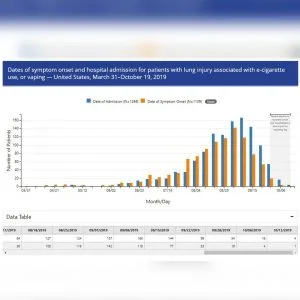The Onset of Vaping-Related Illness
In September of 2019, numerous news reports began to emerge regarding vaping-related illness and lung disease. Both the CDC and various news media sources provided scant specific information on these incidents.
The Media’s Role
The media effectively grouped all vaping into one category, suggesting that any use of vaping or e-cigarette products was dangerous and causing illness.
The CDC’s Findings
In the vast majority of incidents reported to the Center for Disease Control – 86% – the users of the vaping products reported using vapes with THC in their devices. [Source] The CDC also suggested that many of the THC Vape pods were not purchased from reputable stores and distributors, but received from friends and family, or purchased from the streets. [citation] The CDC stated on their website: “THC is present in most of the samples tested by FDA to date, and most patients report a history of using THC-containing products”.
The Issue of Self-Reporting
An additional concern with this type of self-reporting is that if an individual is underage, or lives in a State where marijuana products are illegal, they may not disclose their THC/marijuana use.
The CDC’s Record Keeping
The Center for Disease Control has been keeping a record of all patients being admitted to the hospital for these vaping-related illnesses. These results have been reported on a weekly basis.
The Reduction in Vaping-Related Illness
The week with the highest reported incidents was September 8, 2019. During this week, 166 individuals were admitted to the hospital due to lung injury, and 118 patients had experienced symptoms of this lung injury. Contrast that with their most recent reported week, October 6, which had 16 admissions into the hospital and 4 people reporting symptoms. In less than two months, this is a reduction of 90.3% of people hospitalized, and a reduction of 96.5% in patients with symptoms of vaping-related illness.
The Implications of the Reduction
The reason for this reduction is not known, but the incredible reduction has not been in the forefront of the news stories or reports. If you factor in that there are approximately 327 million people in the United States, with an estimated 9% of Americans vaping [source], this is 29.4 million current vapers in the United States. With four individuals experiencing vaping-related illness during the week of October 6, this equates to just a 1 in 7.3 million chance of being affected by this vaping-related illness. If you factor in that an estimated 90% of the current individuals who experienced this lung disease have been using THC products, this number reduces further to a one in 73.5 million chance.
The Question of Regulation
This begs the question – does something that has a one in 73 million chance of illness warrant a continued, fear-mongering outcry against it? Does it require congress to rise up to ban flavors, and in Massachusetts, ban all vaping products across the state? Considering the majority of nicotine vaping users are people using the products to quit smoking, and smoking kills 5 Million people each year- [source], vaping is much safer than smoking, and safer than many things we do every day without concern.
The Future of Vaping
With the increased knowledge regarding the dangers of using unregulated THC products acquired from unknown sources, the reduction of vaping-related illness should continue. We fear that the media’s blanket statements suggesting ‘all vaping products are dangerous’ has caused so much fear in many nicotine vaping ex-smokers, that it’s pushing them back to cigarettes.
Ultimately, until the government fully regulates all marijuana and THC products, as well as all nicotine vaping products, we could continue to see illnesses and quality control issues within the industry.


